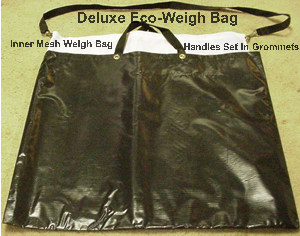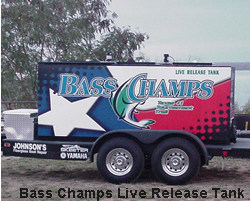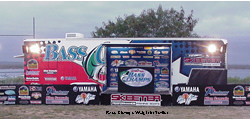OBSERVATIONS ABOUT AND CONSIDERATIONS
FOR TOURNAMENT WEIGH INS
By Larry E. Bridgeman
I admittedly have a bias
(one of many) that every Bass Club and Tournament Organizer should
have conservation as a primary goal. If catch, kill and eat is the
plan, it will not be long before fish population in any active tournament
reservoir will begin to suffer and the only equipment you need for
weigh in is a set of scales and an ice chest. These are my thoughts
on this process.
SEVERAL
THINGS NEED TO BE DONE TO ASSURE THE MAXIMUM NUMBER OF FISH SURVIVE
A TOURNAMENT. Some
of these things are so basic that you would think them obvious and
no mention should be necessary. However, time after time I see these
aspects ignored or violated resulting in the needless deaths of many
good fish and the resultant elimination of millions of fry from the
upcoming spawns:
THE
TOURNAMENT PLANNING PROCESS FOR ANY MAJOR EVENT MUST INCLUDE, before anything else, designation
of an individual as Tournament Director who is responsible for every
aspect and should ideally not be a tournament participant. Without
this individual who will man the PA system and keep everything moving,
any major tournament is doomed, as are the fish.
ESTABLISHMENT
OF A GOOD SET OF RULES AND THE DATE FOR THE FUNCTION IS THE ABSOLUTE
FIRST CONSIDERATION. As an example, do not have a major Tournament in South
Texas lakes from May to Mid-October unless you are planning on a
50% or more death rate of fish as an acceptable loss. Live well hauling,
100-degree temperatures, multiple handling, multiple periods without
oxygen and fish survival are incompatible. RULES must take into consideration
the number of boats and the number of flights, departure location(s),
fishing hours, weigh in times and a number of other things about
which volumes of recommendations have been written and published.
Etc. The RULES need to be fair for everyone, but fairness to the
fish is the paramount consideration and should drive the process.
I would recommend the following as a required reading for any organization
contemplating tournament activity.
REFERENCE: A MANUAL FOR ORGANIZING
AND CONDUCTING BASS TOURNAMENTS By Bass Anglers Sportsman Society® http://home.comcast.net/~scy33613/html/manbasstour.html
TEMPERATURE
AS A SURVIVAL FACTOR CANNOT BE MINIMIZED. Although I have never seen this done,
it is possible prior to a tournament to question people knowledgeable
about current depths at which fish are being caught and even to survey
the lake prior to a tournament to determine the average temperature
at this depth. Using a depth thermometer, with the probe lowered
to that depth, check the average temperature. Announce this prior
to the tournament and encourage anglers to maintain live well water
at this temperature. You are going to need some ice blocks and a
thermometer for each boat. Equalize, as close as possible, the live
well (and/or holding tank) water to that of the water at the depths
they were caught." Too Cold" is not good and neither is *Too Warm".
Variations should be 5 degrees or less.
A
SUBSTANTIAL PENALTY SHOULD BE ESTABLISHED AS A TOURNAMENT RULE
FOR ANY DEAD FISH WEIGHED. I
would prefer to see a dead fish disallowed entirely. This might encourage
dumping a dead fish, but there should be a lie detector (ld) and
this should be a ld question ESPECIALLY ON ANY MONEY TOURNAMENT.
An ice chest should be available as a depository for any dead fish.
Remember few, if any dead fish will live. Just because they have
a flicker of life does not mean they  are going to survive. Post-release
mortality can be as high or higher than the pre weigh rate. Proper
handling from the boating of the fish to the release with a proper
net, gloves (to reduce Slime loss) and recirculating live well (plus
a properly applied live well additive (like Rejuvenade or Please
Release me) to relieve stress and replace slime coating) are all
important factors. The importance of having a Rule that requires
(under penalty of disqualification) every fish weighed to be brought
to the scales alive in a weigh bag containing adequate (define) water
from the live well, cannot be minimized. I have seen instances where
small children are allowed to grab and handle fish by organizers
who seem to be impervious to damage to slime coatings or other factors
affecting fish survival. In a recent tournament, fishermen brought
fish to the scales in their hands (no weigh bag-no water). Speaking
of weigh bags, one of the best I have ever seen comes out of Arkansas.
FSA has a bag that features an inner mesh bag that will drain water
into the black bag when lifted out. After fish are weighed in the
mesh bag, they can be replaced in the outer bag holding water for
transport to the release site or live release tank. This eliminates
the need to touch the fish 3 or 4 times as well as the practice of
emptying water and transporting fish dry. They are 23" x 25", have
strong strap handles set in grommets and they are capable of handling
5 Falcon lunkers. This will dramatically improve fish survival and
most clubs' weigh-ins can function effectively with 5 to 10 of these
bags.
are going to survive. Post-release
mortality can be as high or higher than the pre weigh rate. Proper
handling from the boating of the fish to the release with a proper
net, gloves (to reduce Slime loss) and recirculating live well (plus
a properly applied live well additive (like Rejuvenade or Please
Release me) to relieve stress and replace slime coating) are all
important factors. The importance of having a Rule that requires
(under penalty of disqualification) every fish weighed to be brought
to the scales alive in a weigh bag containing adequate (define) water
from the live well, cannot be minimized. I have seen instances where
small children are allowed to grab and handle fish by organizers
who seem to be impervious to damage to slime coatings or other factors
affecting fish survival. In a recent tournament, fishermen brought
fish to the scales in their hands (no weigh bag-no water). Speaking
of weigh bags, one of the best I have ever seen comes out of Arkansas.
FSA has a bag that features an inner mesh bag that will drain water
into the black bag when lifted out. After fish are weighed in the
mesh bag, they can be replaced in the outer bag holding water for
transport to the release site or live release tank. This eliminates
the need to touch the fish 3 or 4 times as well as the practice of
emptying water and transporting fish dry. They are 23" x 25", have
strong strap handles set in grommets and they are capable of handling
5 Falcon lunkers. This will dramatically improve fish survival and
most clubs' weigh-ins can function effectively with 5 to 10 of these
bags.
HOURLY
WEIGH-INS AND REDUCED LIMITS CAN HELP IMPROVE SURVIVAL RATES. Consider changing rules to
make the tournament fish friendly. I believe technology will someday
come to the rescue of tournament fish and the weigh and release process
will be revolutionized. It will be possible to integrate automated
culling, weigh in and transmittal of results with the immediate release
back to the water facilitating the end goal of fish survival. In
the interim, reducing limits to three fish (especially May 1 to October
31), having mandatory hourly weigh-ins of fish over 5 lbs, and assuring
all livewells are functioning properly before allowing participation
should all be observed as priorities.
 A
TOURNAMENT DIRECTOR's (TD) responsibility is not a social
one in any major tournament. The TD chief duty is to man the PA
System and expedite the weigh in process, keep it moving and stage
it so fish remain in
A
TOURNAMENT DIRECTOR's (TD) responsibility is not a social
one in any major tournament. The TD chief duty is to man the PA
System and expedite the weigh in process, keep it moving and stage
it so fish remain in  an oxygenated environment the majority of
the time. Jim Murray Tournament Director for Honey Hole, Media
South and many other circuits/events was the all time master at
this process and watching him do his thing was the basis for my
understanding of proper tournament technique. You must have someone
who can observe, evaluate and respond. Any single missing ingredient
will not facilitate your achievement of the desired results. If
you have not seen a good operation it will be hard for you to know
what is needed. I suggest you attend a Bass Champs event and
watch how they do it.
an oxygenated environment the majority of
the time. Jim Murray Tournament Director for Honey Hole, Media
South and many other circuits/events was the all time master at
this process and watching him do his thing was the basis for my
understanding of proper tournament technique. You must have someone
who can observe, evaluate and respond. Any single missing ingredient
will not facilitate your achievement of the desired results. If
you have not seen a good operation it will be hard for you to know
what is needed. I suggest you attend a Bass Champs event and
watch how they do it.
A
FISH OUT OF WATER -Very
few fish are going to survive a half hour out of the oxygenated water
even in a weigh bag. Standing in line holding fish in a weigh bag
makes no sense when they could be in the live well instead. As discussed
above, weigh bags are not all created equal. There are bags available
that have an inner-mesh bag that can be lifted out and will auto
drain and eliminate several handling processes entirely. On the other
end of the continuum, I have seen weigh ins where anglers actually
bring fish to the scales holding them by their lower jaws with no
bag or water. These fish-felons, masquerading as tournament anglers,
should forfeit their fishing licenses or at least be refused a weigh-in.
Clubs and tournaments should come down hard on this insensitivity
and gross neglect.
FISH
FLOPPING around in
a weigh basket (or dropped on the ground) can either injure themselves
or each other. Always have a weighted cover that can be placed on
top of the weigh basket fish so as to minimize their activity during
weigh in and reduce the time out of water These are some of my major
concerns that I believe need to be addressed in the process of tournament
weigh ins and there is a lot of research to support these tenets:
INFO FROM: http://www.wildlife.state.nh.us/Fishing/tournament_bass_guidelines.htm
WATER
TEMPERATURE TOLERANCE for bass depends on the temperature to which it is acclimated. Fish
living in 65º water cannot tolerate warmer water temperatures
(>78º) as well as fish living in 75º water. A rapid
temperature increase of 5º or a rapid temperature decrease of
10º can be lethal to bass. Bass metabolism increases rapidly
as water temperatures go up - meaning bass need more oxygen, consume
it more rapidly, at a time when the water's ability to hold more
oxygen is declining. Therefore it takes more aeration of the live
well water to keep bass alive at warmer temperatures. Live well water
quality constantly changes during the tournament day as bass excrete
metabolic waste in the form of ammonia, which is highly toxic to
the fish with the toxicity increasing with water temperature. The
build up of ammonia is easily resolved by continuous pumping of fresh
water into the live well.
STRESS is a major cause
of delayed mortality in tournament caught bass. Reducing stress to
these bass requires three things: reducing handling injuries and
loss of protective mucus; healthy conditions in the boat live well;
and, quick, efficient weigh-ins where fish are subjected to minimal
handling while maintained in adequate life-supporting conditions
throughout the weigh-in process. Some procedures to expedite fish
release (and thus reduce initial mortality) include: staggering start
and weigh-in times, having shaded holding tanks with flow through
circulation systems available at the weigh-in, not holding weigh-ins
when air temperatures are > 90°F, and transporting fish from
live-well to weigh-in in water-filled plastic bags (the time fish
remain in water-filled plastic bags should be less than 10 minutes).
MORTALITY
STUDIES have found
larger black bass experience greater initial mortality than smaller
black bass, indicating capture and confinement in live-wells appears
to be especially stressful to larger fish. It is essential that losses
of large black bass in northern populations are minimized since larger
males and females spawn earlier in the spring, allowing the resulting
progeny to accumulate more energy reserves prior to entering their
first wintering period, which increases their chance for survival.
Tournament organizers can address this issue by adopting big fish
or big fish/hour formats that reduce the time large bass are held
in live-wells before weigh-in and release. Initial mortality has
also been positively related to daily limit, and mean weight and
number of fish per angler.
REDUCE
LIMITS studies show that the daily limit is the
single most influential variable affecting initial mortality. Tournament
organizers can address this concern by implementing reduced daily
limits.REFERENCE: Recommendations contained within the B.A.S.S
publication "Keeping Bass Alive: A Guidebook
for Anglers and Tournament Organizers," which is available by contacting:
B.A.S.S. Conservation Department 5845 Carmichael Road Montgomery,
AL 36117 email: conservation@bassmaster.com
 About the Author: Larry Bridgeman is the owner of Falcon
Lake Tackle in Zapata Texas and a former guide on Falcon with some
45 years fishing under his belt with 35 years fishing Falcon. For
the last six years, he and his wife Barbara have been selling fishing
tackle from their store in Zapata, Texas to local and club fishermen
as well as to customers in 48 states and 8 foreign countries via
their online store. They have developed their store into one of the
best-stocked stores in Texas featuring over 5000 lures and tackle
selections used and recommended by their customers, many of which
are tournament fishing professionals. Their specially is magnum tackle
and lure selections designed to withstand the bone jarring strikes
of South Texas and Mexico Bass.
About the Author: Larry Bridgeman is the owner of Falcon
Lake Tackle in Zapata Texas and a former guide on Falcon with some
45 years fishing under his belt with 35 years fishing Falcon. For
the last six years, he and his wife Barbara have been selling fishing
tackle from their store in Zapata, Texas to local and club fishermen
as well as to customers in 48 states and 8 foreign countries via
their online store. They have developed their store into one of the
best-stocked stores in Texas featuring over 5000 lures and tackle
selections used and recommended by their customers, many of which
are tournament fishing professionals. Their specially is magnum tackle
and lure selections designed to withstand the bone jarring strikes
of South Texas and Mexico Bass.

